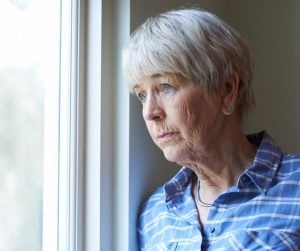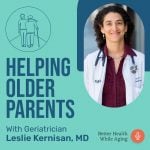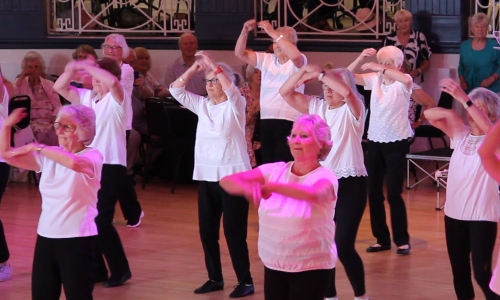

Most of us can relate to feeling sad or blue, sometimes for days at a time. It may be in response to a major life event like losing a job, a break-up, or as part of grief. These sad feelings can lead us to feel less interested in enjoyable activities, make us lose our appetite or disrupt sleep.
Although research shows that people often become happier as they age, sad feelings are also very natural and can be associated with some of the typical transitions and changes of aging. But clinical depression, from a medical point of view, is something different, and should not be considered a normal part of getting older.
In this article, I’ll explain the most important things to know about late-life depression, including:
- What’s different about depression in later life?
- What are the symptoms of depression and how is clinical depression diagnosed (especially in an older person who may also have medical illnesses that can mimic depression symptoms)?
- What does testing for depression look like?
- What treatments are recommended for older adults with clinical depression?
- What you can do if you’re worried that someone is depressed, and how to help someone with depression.
In an upcoming article, I’ll also cover the special considerations and challenges when it comes to diagnosing and treating depression in those living with dementia, which is a common scenario in my practice as a geriatrician.
Depression in Later Life
It’s a common belief that sadness is a natural part of aging, and that it would be understandable for older adults to have a high rate of clinical depression, but that’s not true.
About 2% of those over 65 meet criteria for major depression, compared to around 6% in the general population. That said, the likelihood of depression rises significantly when there are other illnesses present: up to 40% of older adults with stroke, heart attack, or cancer are depressed, as are 30% of those in hospital.
Depression doesn’t always fit a typical picture in older adults. We think of a depressed person as being sad, hopeless, tearful, and withdrawn. Although many older adults do express the “classic” signs of depression, such as persisting sadness or loss of interest in activities they used to enjoy, older adults are more likely to have other depression symptoms, which can include:
- Preoccupation with bodily complaints (often bowel function, pain, or sleep issues).
- This can delay the depression diagnosis as medical tests and treatments are done to rule out physical illnesses, or to treat these conditions (which are common in late life and can co-exist with depression).
- Delusions, which are fixed, false beliefs that, in depression, usually have a negative connotation, like the person is guilty of a crime, is financially devastated, or is dreadfully ill.
- Social withdrawal and decreased interaction with care partners.
- Lack of motivation with a treatment or rehabilitation plan (this is often a trigger for a depression evaluation in hospitalized elders).
- More symptoms of anxiety rather than low mood.
Anxiety is a common companion of depression, especially in later life. Almost half (47.5%) of older adults with a major depression also meet criteria for an anxiety disorder. Anxiety causes uncontrollable and extreme worrying, irritability, difficulty concentrating, sleep disturbance, fatigue, and restlessness. Thankfully, many of the treatments for depression help with anxiety symptoms too.
Like most things in geriatrics, diagnosing clinical depression is not simple, and requires a blend of art and science to properly sort out. Ignoring a major depressive disorder can have serious consequences, and may:
- Increase the risk of falls and disability
- Increase the risk of dementia or cognitive impairment
- Cause short-term brain function changes: slower processing speed, poor concentration, and more trouble with planning and social interaction
- Worsen the effects of other health conditions
- Increase the risk of death by suicide
How is Depression in Aging Adults Diagnosed?
Most depression in later life is detected and treated by primary care providers. Unfortunately, it’s a diagnosis that’s often missed. The recent National Ambulatory Medical Care Survey (NAMCS) found that depression is 56% less likely to be diagnosed in older patients. This may be related to:
- Fear of stigmatization
- Depression symptoms being mistaken for medical illness symptoms
- Atypical depression symptoms (for example pain or insomnia rather than sadness)
- Focus on other medical issues and lack of time to talk about mood
- Ageism and a presumption that feeling down is “normal” because of age or medical problems
Like most mental health disorders, doctors make a diagnosis of clinical depression based on the person’s symptoms, instead of relying on blood tests or brain scans.
Major depression is a disorder with low mood that causes significant problems in day-to-day life, such as work, family responsibilities and relationships. There are also forms of depression which are less severe. Minor depression causes fewer symptoms, and may not be as disruptive, and dysthymia, or persistent depressive disorder, is a low-grade depressed mood that may last a few years or longer.
The most widely accepted definition of major depression is in the Diagnostic and Statistical Manual of Mental Disorders, Fifth Edition, also called the DSM-5 (American Psychiatric Association, 2013).
What are the symptoms of clinical depression in older adults?
According to the DSM-5, depression symptoms must:
- Include low mood or include loss of interest or pleasure in previously enjoyable activities (the medical term for this symptom is “anhedonia”)
- Be a change from a previous level
- Be present for at least 2 weeks
- Cause distress or impairment in day-to-day life
- Not be due to another medical condition or substance
Along with low mood and loss of interest, the DSM-5 criteria require 5 or more additional depression symptoms to be present, which I remember by the mnemonic “SIGECAPS”:
- Sleep problems (too much or too little)
- Loss of Interest in pleasurable activities
- Feeling worthless or Guilty
- Fatigue or lack of Energy
- Concentration and thinking difficulties
- Appetite changes or weight loss/gain
- Physical slowing
- Suicidal thoughts
Looking at that list, you might notice that many of those symptoms could be caused by other medical issues common in older adults. Parkinson’s disease for example causes physical slowing and lack of energy, chronic pain disrupts sleep and affects appetite. This can make late-life depression diagnosis tricky, since medical conditions can not only mimic depression, but some common health issues heighten the risk of a depressive episode.
Medical conditions that are associated with depression:
- Cancer (particularly pancreatic cancer, lymphoma and leukemia)
- Stroke
- Heart attack
- Underactive or overactive thyroid
- B12 deficiency
- Elevated blood calcium level
- Cushing’s disease (which causes an increase in cortisol)
- Vascular cognitive impairment and vascular dementia
- Parkinson’s disease
- Alzheimer’s disease
- Side effects of certain medications
- Alcohol or other substance use disorder
Bereavement or grief after a loss is another situation that can complicate the diagnosis of depression. Losing a spouse or experiencing another life event that causes significant grief can cause sadness and many symptoms that overlap with depression. Although most people going through bereavement don’t meet the criteria for depression, experts agree that bereavement can trigger depression in some people. So especially if distress and sadness persist after a loss, it’s a good idea to pursue evaluation for depresssion.
Depression Testing Tools
To help us tease out whether an older adult has depression, geriatricians often use screening tools developed for older adults, such as the Geriatric Depression Scale (GDS) or the Cornell Scale for Depression in Dementia. These are easy-to-use questionnaires that help determine if an older person is depressed or not. The questions on the assessment tool cover aspects of emotional wellness and meaning that the SIGECAPS checklist can miss. Let’s look at one of these tools more closely.
The Geriatric Depression scale, or GDS was developed in 1982 at Stanford University. The first version was 30 “yes or no” questions, covering aspects like interest in hobbies, memory changes, energy levels, feelings of sadness, hopelessness, and helplessness. Depending on the answer, a point is given and the higher the score, the more likely there’s a depression.
Using a cut-off of 11, the sensitivity (a positive test makes it likely that the person is truly depressed) was 84% and specificity (a negative test makes it very unlikely that a depression has been missed) of 95%. Those are fairly good numbers, and the GDS is very widely used. Busy clinicians love to make tests faster and easier if they can, and the GDS has a 15-question version (the one I use the most often in my practice) and a 5-question version.
The questions in the 5-item GDS are:
- Are you basically satisfied with your life?
- Do you often get bored?
- Do you often feel helpless?
- Do you prefer to stay at home rather than going out and doing new things?
- Do you feel pretty worthless the way you are now?
Two out of five depressive responses (“no” to question 1 or “yes” to questions 2 through 5) suggests the diagnosis of depression, with a 94% sensitivity and 81% specificity.
I actually prefer the 15-question version of the GDS, which you can find here. It doesn’t take very long to administer, and I find it gives me a better feel for how an older person is experiencing their life.
There are other screening tools in common use, like the Patient Health Questionnaire-2 (PHQ-2), which is two questions about sadness and loss of interest. The Cornell Scale for Depression can be used if the person with depression symptoms has dementia or another cause of cognitive impairment and uses data from an observer (like a caregiver) as well as the patient.
Depression screening questionnaires are a handy tool, but by themselves, they can’t confirm a depression diagnosis, and a thorough assessment is still required.
Many older adults are experiencing natural transitions and losses or undergoing stresses related to caregiving or health issues. Running through the GDS helps not only with depression diagnosis but also with determining areas in the person’s life that may be worth exploring in more detail, and finding ways to offer support.
How Doctors Evaluate Possible Depression in Aging Adults
Sometimes, an older adult is “brought in” to the doctor’s office because someone else thinks they’re depressed. (Watch this video “Is my dad depressed?” to learn more). If that’s the case, the primary care provider will likely talk to the concerned relative and the person who may be depressed, either together or separately. They’ll ask about all of the things in the “SIGECAPS” checklist and may probe for symptoms of medical conditions that can mimic depression.
It’s vital to bring an up-to-date and complete list of your medications to the visit and make sure your primary care provider is aware of how much alcohol, cannabis, or other non-prescription substances you consume.
Medications that can cause or worsen depression include:
- Steroids (Prednisone)
- Beta-blockers (propranolol, for example)
- Benzodiazepines (Valium, Restoril, Rivitril, Serax)
- Anti-Parkinson’s drugs
- Estrogen and Progesterone
- Hydralazine
- Clonidine
…and don’t forget alcohol, which is a CNS (central nervous system) depressant.
In addition to a medication review, your doctor may:
- Administer a Geriatric Depression Scale or other mood assessment test (as we mentioned above).
- Ask about suicidal thoughts if the older person has a plan to end their own life. This may seem like an offensive or intrusive question, but it’s something that doctors and nurses are trained to ask of people who are depressed. Suicide is more likely in those with depression, and although older adults attempt to end their own lives less frequently, they are more likely to complete suicide than their younger counterparts. Twenty-four percent of completed suicides happen in older adults, with older men having the highest suicide rate of all age groups (29 per 100 000). Risk factors for suicide in elders include chronic pain, social isolation, widowhood, physical illness, and prior suicide attempts.
- Ask about hallucinations or delusions. Fifteen to 45% of older adults with depression may have a psychosis as well. (Learn more about paranoia here: 6 Causes of Paranoia in Aging and What to Do). This may be one of 2 types, or sometimes both:
- Hallucinations: sensory experiences that are not based in reality (unusual smells, visions, voices or noises, or tactile sensations). (Learn more about hallucinations here: When it’s not a hallucination video).
- Delusions: a persistent false belief (that they are terribly ill, are being robbed or poisoned, or that a partner is being unfaithful, for example).
- Psychotic symptoms can make depression more complicated to treat and can understandably be very distressing for patients and families.
- Review family history, as depression can run in families. That said, those who have their first episode of depression later in life are actually less likely to have a family history of the condition.
- Consider bloodwork, which is usually done to rule out other conditions that can mimic depression, by causing depressed mood, irritability, or even psychosis. Although there’s no blood test or scan that reveals depression, it IS often appropriate to order tests to rule out depression mimics. I often check blood glucose, calcium levels, thyroid function tests and Vitamin B12 levels. (Learn more about lab tests here: Understanding Laboratory Tests: 10 Commonly Used Blood tests for Older Adults).
- Assess for signs of cognitive changes. This can be done by asking questions or even doing a brief cognitive test, such as the Mini-cog, during the visit. The tricky part is that the relationship between depression and dementia is complex and evolving. Severe depression can make someone look like they have dementia when they don’t (sometimes called “pseudo-dementia”) and some people with dementia have depression as part of their condition. (Learn more here: Is it Depression or Pseudo-dementia?).
How Depression in Older Adults Can be Treated
Untreated depression in later life is a serious problem. It can worsen many medical conditions, it affects quality of life, and it can lead to more use of alcohol and illicit drugs.
Depression has also been found to increase the risk of death in those moving to nursing homes, recovering from stroke or heart attack, or in hospital for any reason. And, it can result in suicide, which is tragic and should be prevented if at all possible.
So it’s essential to help older adults get treated for depression. Depression treatment may consist of one or more of:
- Medication
- Psychotherapy
- Physical Exercise
- Other treatments
The goal of treatment is to induce a remission from symptoms and maintain this response for as long as possible.
Medications to treat depression in later life:
Antidepressants are effective in the treatment of depression in cognitively intact older adults. (Unfortunately, research shows they are much less effective in people with dementia.)
Anti-depressants do sometimes cause side-effects, and have also been associated with an increase in fall risk. For these reasons, it is sometimes reasonable to try to first treat depression with non-pharmacological approaches, such as psychotherapy (see below). That said, the likely benefits of antidepressants often outweigh the risks.
There have been many scientific clinical trials of antidepressants. A systematic review of 51 well-designed studies, which included over 2600 patients over age 55, showed that antidepressants were better than a placebo to produce a remission from depression. Response rates are around 30-50%. More analysis of the systematic review did show that with older age (over 65), the effectiveness of an antidepressant goes down, and potential for side effects goes up.
Although it’s not clear that any one class of antidepressant is more effective than another, some are less likely to cause side-effects or drug interactions, and those are the medications that geriatricians often use. An analysis of 12 newer antidepressants showed that sertraline and citalopram (which we have traded in for its more potent version escitalopram) were the ones that were easy to take and seemed to work well, and are ones that I’ve used in many of my patients.
(Learn more here: Medications Older Adults Should Avoid or Use with Caution, and Anticholinergic Meds- What You Need to Know (video)).
Important to know when starting an antidepressant:
- Medications can take some time (usually at least 3 – 6 weeks) to start working.
- In older adults, we start with a low dose which is slowly increased over days to weeks to reach a therapeutic level.
- Many times, we have to try more than one antidepressant to find one that works and is tolerated by an older person. It’s also sometimes needed to use more than one antidepressant at a time.
- Stopping an antidepressant “cold turkey” can cause discontinuation syndrome. This isn’t due to addiction, but if someone has been on an antidepressant for a while, we slowly taper it off to prevent a rebound of depressive symptoms or other unpleasant side effects.
- While the medication adjustments are being made, other treatment plans can kick into action, like cognitive behavioral therapy, another form of psychotherapy, or an exercise program (see below).
- Remission is more likely when more than one treatment modality is used at the same time (like medication and counseling for example).
- Most older adults need to stay on an antidepressant for 6 months to a year to remain in remission.
This table has a summary of some of the most commonly used antidepressants in older adults.
| Medication family | Examples | How they work | Possible Side Effects |
| Selective Serotonin Reuptake Inhibitors (SSRIs) |
|
Increases brain serotonin levels |
|
| Serotonin-Norepinephrine Reuptake Inhibitors (SNRIs) |
|
Increase brain levels of norepinephrine and serotonin |
|
| Atypical Antidepressants |
|
Mirtazapine is a tetracyclic that increases serotonin and noradrenaline
Bupropion blocks the reabsorption of norepinephrine and dopamine
Trazodone is a serotonin modulator that increases serotonin activity on the brain
|
|
| Tricyclic Antidepressants |
|
Increase levels of serotonin and norepinephrine |
|
Other medications: Antidepressants are sometimes augmented with medications from a class called antipsychotics, such as aripiprazole or quetiapine. These drugs increase dopamine and serotonin levels and, when added to an antidepressant, they make it more likely that an older person will get relief from their depression symptoms. We use the antipsychotics very carefully though, because they can cause reversible side effects like muscle stiffness and slowing (a syndrome also called Parkinsonism).
Psychotherapy to treat depression:
This can take the form of counseling, interpersonal therapy, problem-solving therapy, or cognitive behavior therapy (CBT), among other therapy types. Psychotherapy is safe for older adults, and a systematic review of 23 studies of psychotherapy for depression showed that it was effective. Limiting factors can include the availability of a qualified therapist and cost if the older adult doesn’t have insurance coverage.
Exercise to treat depression:
From a physiologic standpoint, exercise has immediate and long-term benefits for mood. Vigorous physical exercise increases levels of helpful chemicals like brain-derived neurotrophic factor and suppresses the release of inflammatory cytokines. It can also be a mechanism to reduce social isolation and help to manage pain and other medical issues.
There’s scientific evidence that exercise helps with late-life depression symptoms. Cardio and weight resistance training are both effective, and most of the studies involved 30–45-minute sessions 3-5 times per week.
You can learn more about exercise in aging here: 4 Types of Exercise in Later Life: How to maintain strength, balance, & independence in aging.
Other treatments for late-life depression:
Medication, psychotherapy and lifestyle changes like exercise and increasing socialization are the mainstays of late-life depression treatment. But there can be other approaches that might be used, especially if the depression symptoms are:
- Unresponsive to medication and psychotherapy
- Severe and life-threatening
- Associated with psychotic features or catatonia (a rare condition with extreme emotional withdrawal and muscle stiffness)
- Associated with extreme weight loss or reduced food intake
Electro-convulsive Therapy (ECT), for example, is used in older adults more often than younger ones, and is much more effective than many people realize. It can produce a rapid response after only a few treatments, may have a safer side effect profile than medication, and may be more effective than medications.
Unfortunately, this treatment is associated with negative connotations, especially among older adults who may recall less sophisticated versions of the treatment from decades past. A side effect of ECT can include reduced short-term memory performance, but this effect is usually short-lived (less than 2 weeks). Cognitive performance is more likely to improve, in fact, as the depression symptoms get better. ECT is almost always done under the supervision of a psychiatrist, rather than a primary care provider.
Bright light therapy is another type of treatment that has been shown to be effective to treat depression in older adults. A 2018 systematic review found that white and pale-blue light seemed especially effective.
Can late-life depression be prevented?
We know that older people with medical conditions like stroke, vascular dementia, and coronary artery disease are at higher risk for depression in later life. We don’t have good evidence that depression can be prevented through any specific supplement or medication, but given depression’s connection with vascular disease, it seems that the best advice is to maintain heart-healthy habits. Starting in mid-life, I would recommend regular exercise, stress and weight management, and seeing your doctor about your blood pressure and cholesterol as needed.
Key messages to take away:
- Depression isn’t a normal part of aging, but it can affect older adults and lead to serious consequences if left untreated.
- Depression diagnosis involves a careful review of an older person’s complete medical history, medications, and lifestyle, as well as talking to those close to the older adult and using a screening tool, like the GDS.
- Depression is treatable and has a high rate of remission, although it often takes a few different treatment approaches and maybe more than one trial of a medication.
If you’re worried that someone is depressed:
It’s definitely hard when someone you care about seems to be depressed. Here are things you can do, if you’re worried, or to help someone who has depression:
- Don’t be afraid to ask about depression. Remember that it’s not normal to feel down, simply because of getting older.
- Encourage them to see their primary care provider. Consider pointing out that depression can be caused by a “medical” illness. This might be a way of framing the problem that’s more acceptable to the older person.
- Don’t take it personally if you can’t seem to cheer them up. Depression is a medical illness that takes time and professional guidance to get better. Showing support is a valuable part of helping the person recover and may be all that you can do until the treatment plan starts working.
- If you think the person is seriously considering suicide, seek help right away, by calling 911 if necessary. The Institute on Aging Friendship Line offers a hotline developed for older adults, and is the only accredited crisis line for older adults age 60+.
Suicide Prevention Helplines (available 24/7):
More Helpful Resources:
Please feel welcome to share your experience with later-life depression or ask any questions about it.
Dr. Nicole Didyk is a board-certified geriatrician in Canada and a regular expert contributor to Better Health While Aging. You can learn more from her by visiting her site TheWrinkle.ca, or her aging health channel on YouTube.




